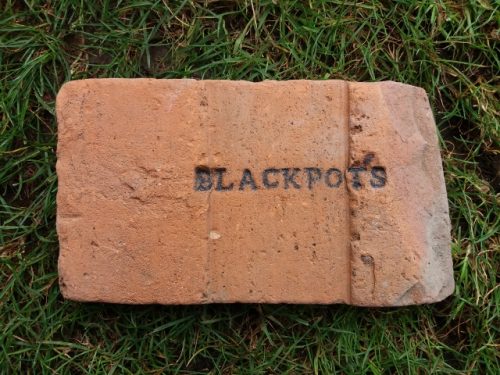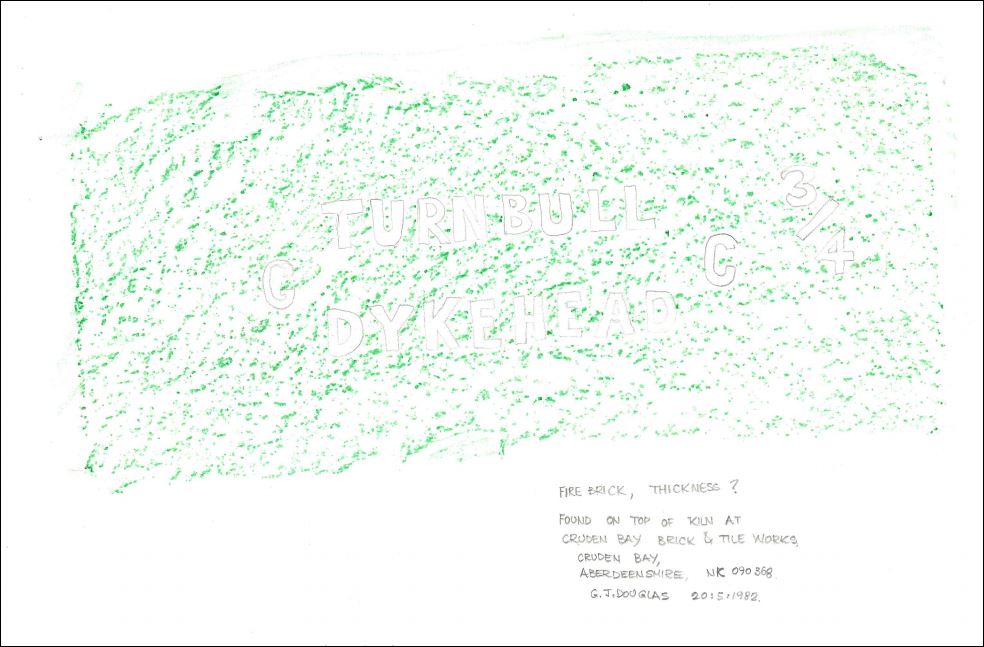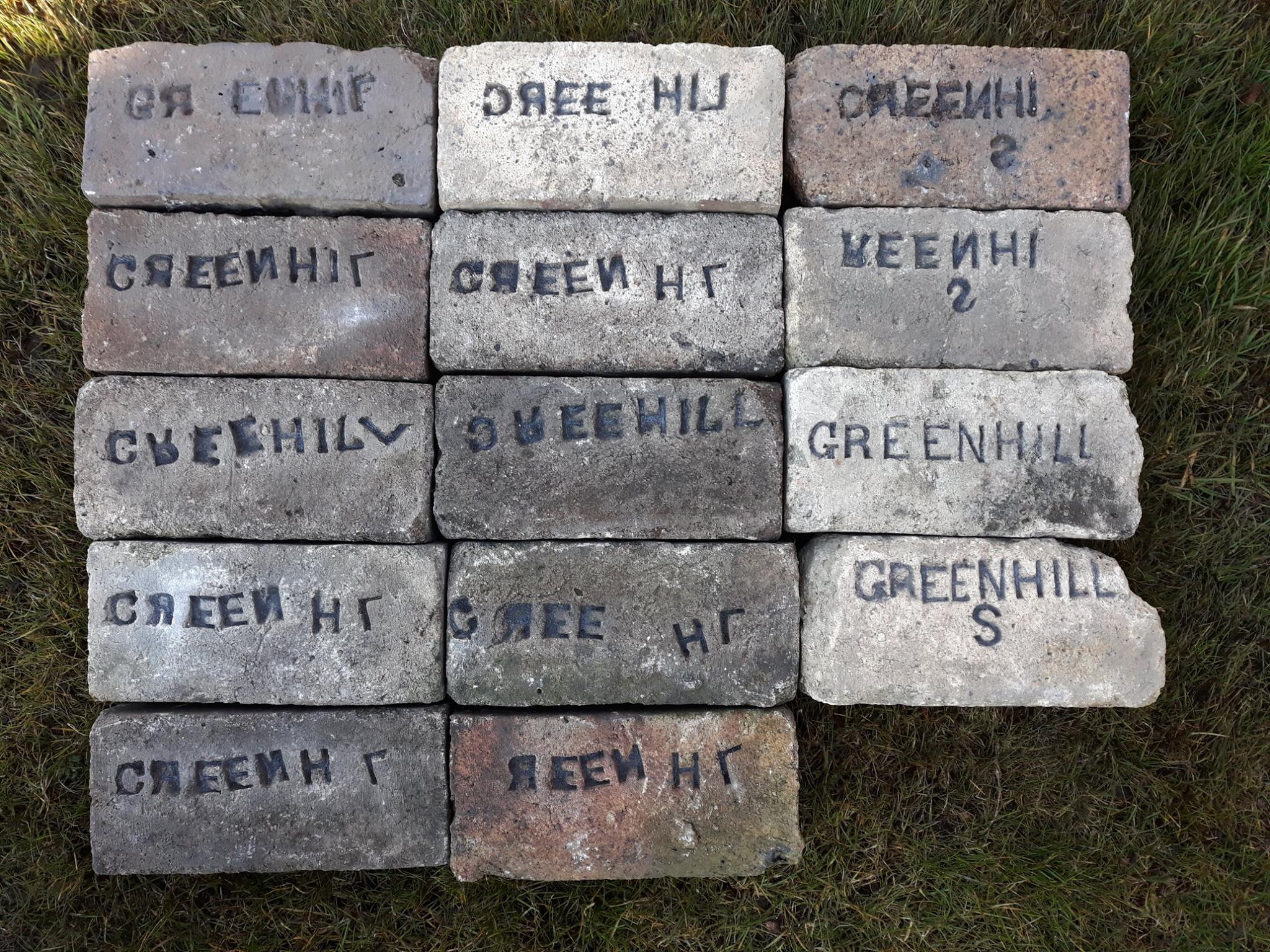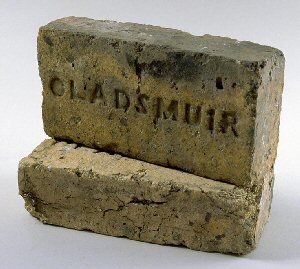Atlas No 3 brick found off Vancouver Island, Canada
— 07/10/2020Found by Bill Kellett. Bill states – This one was found in 2014 or 15 offshore at…
01/06/2023 - All appears well.
If anyone sees a problem please email me at brickmarks@gmail.com
Thank you.
The humble brick is much underrated, underappreciated, undervalued and overlooked. 'Brick' is a generic term and with regards this project it stands for any clay related products manufactured at a Brick and Tile Works - bricks, drainage tiles, sewage pipes, animal feed troughs etc etc etc.
Stand up and be proud - I LOVE MY BRICK!
Father Jack knows the truth of it - Click here.
Found by Bill Kellett. Bill states – This one was found in 2014 or 15 offshore at…
Found by Ian Suddaby at the Manuel Works, Whitecross. This example is not in my possession. The…
Found by Len Baird in East Lebanon, New Hampshire, USA. Len states – I have found GartCraig…
Found by Harley Plowman an old 1800s hotel site in New Zealand. Cardowan Fire Clay Works, Stepps,…
The following bricks were found by Didier Morin-Laprise on the shore at Port-Menier on Anticosti Island, Canada….
Gartcraig brick found in Parque Barrancas de Belgrano, Buenos Aires, Argentina See this link for details of…
Photographed on Robben Island, Near Cape Town, South Africa. The island was used as a leper colony…
These bricks were found by Stephen Misener on the River Herbert, Nova Scotia, Canada. Gartcraig Fire Clay…
Found in Resistencia, Chaco, Argentina by Deigo Maciel. Manufactured by J & R Howie Ltd, Hurlford, Kilmarnock….
Found by Dan Mosier on the bay shoreline, San Francisco, California, USA. Garnkirk Fireclay Works, Garnkirk, Lanarkshire…
Vladimir Smirnov writes:- The bricks were found by Eugeny Filinsky in Abkhazia, Gagra city. It is a…
Found by Peter Churchill at an old gold mine situated at Port Dufferin, Nova Scotia. Canada. ….
Found in the base structure of a former glasshouse in the walled garden of Westport House, Co….
The photos of these bricks were kindly forwarded by Cristina Pasquali an archaeologist and coordinator of the project,…
The following bricks were found on the D’day beach Juno, Normandy, France by Jean luc Marchais. Castlecary…
Crown Fire Clay Works, East Nelson Street, Gallowgate, Glasgow. (1872 – 1873 – Thomas Brownlie of Heatheryknowe…
Lilliehill Fire Clay Works, Townhill, Dunfermline, Fife. Lilliehill Fireclay and Terracotta Works. Messers. Lindsay & Anderson began…
3/10/1881 – Glasgow Herald – Important improvements in burning fire bricks. A new application of heat regeneration….
17/08/1894 – Ardrossan and Saltcoats Herald – … A new coal-pit is being sunk at Warrix, near…
Andrew Mclntyre & Son, brick makers and builders, 1 Titwood place, Strathbungo; Works, Moss Side Brickworks, Crossmyloof…
Canmore Seaton Brick & Tile Co. Limited, Strabathie; Torry; Plaidy; Turriff & Esslemont, Ellon, Aberdeen – To…
Red clay building ricks marked ‘Beardmore Patent’ can be found in and around the Glasgow area. I…
Robert Mackie, Barr Coal Company, Beith 1881 – Robert Mackie, Merchant and John Laird, Farmer, Barrhill, Kilbirnie…
Hangingshaw Brickworks, Cathcart, Glasgow. 10/02/1845 – Glasgow Herald – To brickmakers and others – For sale part…
Many thanks to Gladys Cuttle and the Joseph Thomson Group SC029176 for much of the following information. Gatelawbridge…
Airdrie House Brickworks, Airdrie, Lanarkshire AKA Mosside Brickworks or was this a separate site? Airdrie House (now…
Kilbagie Distillery Brickworks, Clackmannan, Clackmannanshire. Canmore This advert below infers that the Kilbagie Distillery may have had…
The Calder Fireclay Company was founded in 1880 by Robert Fleming & Co with a brickworks at…
The Northern Patent Brick & Tile Co. was a constituent company of the Seaton Brick and Tile…
Below – 1845 – Glasgow Herald – For sale. The minerals in the lands of Craigthorn, in…
Referenced as part of a Highland Council planning application in 2000. 4.2.1 LO/2000/34 Erection of House and…
Below – 1858 – Corehouse Tileworks, Lanark. 1858 – 1861 – ScotlandsPlaces – Corehouse Brick and Tile…
The article below outline bricks for sale at Lennoxlove, Haddington. It does not refer to a brick…
Gushetfaulds Brickworks, Govan, Glasgow. (Note – SBH – This may or may not be what the works…
Dargavel or Dargarvel. See Alexander Whitelaw. 1869 – 1870 – Alexander Whitelaw & Co., brickmakers. builders, and…
Found by Ian Suddaby in Perthshire. This example is not in my possession. Errol Brick and Tile…
Found by Ian Suddaby on Shetland. This example is not in my possession. Errol Brick and Tile…
Found by Ian Suddaby in the Fife area. This example is not in my possession. Errol Brick…
Found by Eddie Mclean in the Glasgow area. Buccleuch Terra Cotta Works, Sanquhar, Dumfriesshire. (N.B – stands…
The following spigot and socket clay water pipes were kindly donated by Dave Walsh. These clay pipes…
Found in the Broughty Ferry area and in the possession of Brian White. This example is not…
Found by Ian Suddaby in Ayrshire, This example is not in my possession. A section of salt-glazed…
Russell Roof Tiles 11/06/1987 – Galloway News – The Annandale Tile Co (1986) Ltd manufacturers of quality…
Found by Ian Suddaby. These examples are not in my possession. They are made from cement/concrete, not…
These are in the possession of Ian Suddaby and were found in the Alloa area. Unidentified manufacturer…
Found by John Philip at Drybridge, Buckie. I am not in possession of this example. Errol Brick…
Found in a reclamation yard in Blackburn, Aberdeenshire by Ian Suddaby. It was left in situ as…
Found by Stephen Young in the Edinburgh area. This example is not in my possession. Ridge tiles….
It appears that as a space-saving mechanism inside kilns, drainage tiles were stacked inside each other during…
Found by Ian Suddaby in the Midlothian area. This example is not in my possession. Gartcraig Fire…

For more photographs please Click here.
If anyone knows the whereabouts of a Drongan marked brick, I would love to hear from them.

I believe they were manufactured at the Drongan Castle Colliery, Drongan, Ayrshire.
Please get in touch if you can assist with an example for this Scottish brick collection
Information is requested on the Blackpots Brick and Tile works, Whitehills, Banff.
I have a roof tile marked Blackpots but as yet a similarly marked brick evades me. Any information on to the whereabouts of such a brick will be gratefully received. Finding such a brick would be a fantastic boost to my Scottish brick collection.

I would also love to hear from anyone that has information on the Blackpots works. Did your relatives work there? Do you have any photographs or headed notepaper bearing the Blackpots name?
 Please click on the following link to see the article with the information gleaned so far.
Click here.
Please click on the following link to see the article with the information gleaned so far.
Click here.
Information of any description is requested with regards the Terregles brick and tile works, Terregles near Dumfries. In particular, I would be interested in knowing if anyone has a marked brick or tile from the works.
From an entry on Scotlandplaces and an old OS map, the works were certainly in operation between 1848 and 1850 when they were owned by M.C Maxwell Esq of Terregles.
I am currently researching these works but the information is scant.
Please click on the following link to see the article with the information gleaned so far.
I am seeking an example of a "John McKnight & Son PLAN Kilmarnock" brick.
Anyone with any information on these brickworks or indeed with knowledge where I may pick an intact brick up for the collection, can contact me via the contact form on this site or directly by email to brickmarks@gmail.com

Any information on these works would be greatly appreciated.
 Please click on the following link to see further information and a link to Tanyas website.
Click here.
Please click on the following link to see further information and a link to Tanyas website.
Click here.

 Please click on the following link to see the article with the information gleaned so far.
Click here.
Please click on the following link to see the article with the information gleaned so far.
Click here. I believe these Greenhill bricks were manufactured at the Greenhill Fireclay Works, Bonnybridge.
The works appear to have started c. 1860 when Alexander and John Scott owned the farm and brickworks at Clayknowes, Bonnybridge.
The bricks were all found in the vicinity of the Greenhill Fireclay Works, Bonnybridge, Scotland. Letters are missing, reversed, upside down and angled. The one thing to note is that the letters are in the correct order as such albeit some are missing. They are all fire bricks. The 'Greenhills' bottom left appear to be a later version and the 'G' appears out of character from the other letters but at least it says, Greenhill! There are other stamps available from the same works with either a smaller font or later machine stamped versions but the names are complete on those.
My own thoughts are that this was a brickworks on its last legs prior to being taken over by the Clayknowes brickworks. As such the moulds appear to have been falling to bits especially the stamp in the bottom. They probably could not afford a mould maker or joiner so the moulder probably had to repair the stamp every morning and try to get the letters to stay in place. Perhaps they were split and could not take a nail to secure them. He appears to know how Greenhill is spelt as no letters are out of order. Basically, I think the moulds were in such a bad state that the moulder was happy if he managed to rig the stamp to say resemble anything that looked like Greenhill.

 There are many many bricks still to trace and rescue. I am looking for all brickmarks and variations that I do not currently possess however the following 2 are being highlighted as 'most wanted' a 'Pinkie, Musselbro' brick from East Lothian and a 'Peter Weir Patent Glasgow' brick from the Glasgow area. If you find any brickmark I do not have then I will do my utmost to uplift personally or arrange postal delivery. Many thanks for your assistance and efforts to save a little piece of Scottish history.
There are many many bricks still to trace and rescue. I am looking for all brickmarks and variations that I do not currently possess however the following 2 are being highlighted as 'most wanted' a 'Pinkie, Musselbro' brick from East Lothian and a 'Peter Weir Patent Glasgow' brick from the Glasgow area. If you find any brickmark I do not have then I will do my utmost to uplift personally or arrange postal delivery. Many thanks for your assistance and efforts to save a little piece of Scottish history.

GLADSMUIR - GLADSMUIR - GLADSMUIR - GLADSMUIR - GLADSMUIR - GLADSMUIR - GLADSMUIR - GLADSMUIR - GLADSMUIR - GLADSMUIR - GLADSMUIR - GLADSMUIR - GLADSMUIR - GLADSMUIR - GLADSMUIR - GLADSMUIR

Aberdonian assistance sought!
Any information as to where to find any bricks manufactured in the Aberdeen area would be gratefully appreciated. I have several bricks marked 'Seaton' and 'Torry' but there will be many more out there, even if they are variations on a theme eg Seaton 5, Seaton 20
In particular, I would love to hear from anyone that has a brick or drainage tile marked Clayhills, Aberdeen.

I would love to hear from anyone who may have a spare Crail brick from Crail in Fife.
An example is currently AWOL from this Scottish National brick collection. Any information on this brick will be gratefully received.



If anyone has found a Scottish brick, anywhere in the world, then please get in touch. If it is abroad I would love to post a small article on my site with regards the overseas find location and any background information you may have
.
If you have found it in Scotland then please drop me an email with the brickmark details and I will check to see if we are aware of its existence. If we are not then I will add it to this National database of Scottish brickmarks. All donations of a currently unknown Scottish brickmark will, of course, be gratefully received. I will arrange a pick-up.
.
Please also send me details of where you think I should look for Scottish bricks, old brickwork sites, foundry sites, river and shore dumps, fly-tipping areas etc. All will be considered for a future visit.

Please click on the link below and see if you can assist with any of the queries or unidentified bricks - research takes a long time so any help in this area would be gratefully accepted.
Thank you

Can I take this opportunity to thank everyone who contacts me with information as to where I might find bricks lying around or indeed those that actually find and put aside a few examples for me to uplift later.
This assistance is greatly appreciated and undoubtedly helps me in trying to rescue as many Scottish bricks as possible. Thank ye kindly.
'Scottish Brick History' is entirely self-funded. If you feel you are in a position to help keep this database available for educational and research purposes then please consider leaving a donation towards the costs of the website, research and searching and travel costs. Your assistance is very much appreciated.
My Paypal email address is brickmarks@gmail.com
********************************************
Please register your interest in Scottish Brick History here for FREE.
